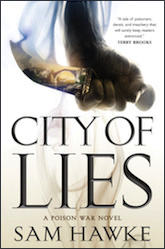One of the debates I’ve had with myself and others over the years I’ve been reading and reviewing fantasy is the question of the definition of “urban fantasy.” This mainly gets into the idea of secondary world fantasies and whether or not a story is set in a secondary world city, where the city is as much a character and changing and evolving place as any of the sentient characters. Are the Ankh-Morpork novels of Terry Pratchett urban fantasy? Leiber’s Fafhrd and the Grey Mouser stories, primarily set in the fascinating city of Lankhmar? The novels of Marshall Ryan Maresca, set in the Archduchy of Maradaine, and showing us an increasing number of facets of his city-state from different points of view and different social classes? Is there a good way to define novels that take this space and make it their own by calling them something better than epic fantasy or urban fantasy? And why do novels that operate in this space, let’s call it city-state fantasy, work? And how do they work when they work well?
Just as it is not urban fantasy, I argue that city-state fantasy is not just a type of epic fantasy, either. Sure, there may be quests and certainly adventure to be found in the alleyways and halls of power of a city, but cities in epic fantasy are very often only points on the road, places to visit, rather than be from and have the plot entirely revolve around. Epic fantasy protagonists from Pippin Took to Rand al’Thor to Gage and the Dead Man certainly visit cities as part or major part of their adventures, but they never have a home city as the heart of their adventures and concerns. It’s a distinctly different sort of reading experience to have characters interact with cities, and characters and the stories they undergo be of cities.
For me, I think it is a two-handed approach of setting and characters in city-state fantasy. You have to create a true sense of place, to ground the reader in enough detail, real and implied, that the city has a personality, an ethos, a style all of its own. The place has to sing and speak as a locale that you can imagine being home to not only the story being told in the book, but the stories of other characters. It has to be an inhabited city. Further, it needs protagonists that are from the city. Using strangers to a city for this purpose is a challenge, because they are as much outside the fabric as we are. But characters who have made a city their home reflect and refract themselves on the city and vice versa, making these fantasies in the end, truly memorable and readable. Dhamsawwaat, in Saladin Ahmed’s Throne of the Crescent Moon, and its characters embody this slice of genre. It may have a map of the Crescent Kingdoms in the front like a good epic fantasy usually does, but its scope, focus and attentions are firmly on the city and it’s characters who are deeply tied to the fabric of the city.
Buy the Book


City of Lies
When the characters and the plot of a secondary world fantasy novel are inextricable from their city setting, and that city is itself a character, then you have city-state fantasy.
And so we come to the latest in this slice of genre: City of Lies, by debut Australian author Sam Hawke. City of Lies tells its story from the perspective of Jov and Kalina, a pair of young siblings of noble rank who are coming of age in the city-state of Silastra. Jov is a poison expert in training, and the male equivalent of a maid-companion to Tain, nephew and heir to the Chancellor of Silatra. Kalina, on the other hand, whose path was to follow Jov’s, is physically disabled and has been trying to find her own path and her own role. The city-state is attacked from within and without: the Chancellor is assassinated, and it is up to Tain, Jov, and Kalina to face the beseiging army that has very coincidentally shown up as all this occurs, while the city-state’s own army is far away on a venture. City of Lies is the story of a city-state under siege, and of two siblings who must grow into their roles, inherited and self-selected, in order to try and save it.
Let’s break down the elements of the novel in detail. The name of the city, Silastra, the Bright City, evokes Renaissance Italian city-states, and that is the model that works well here. It’s a trading hub, the focal point of important trade routes without good alternatives, but a land based one, not a maritime one. We get some hints and details of other polities, near and not so near, and a nearby fractured political landscape, making the city-state front, center. Although there are nearby mines and terrain that prefigure into the plot, it is Silastra that shines here. There is no map in the book, which is a real shame, even as the author lovingly and expertly describes the walled city-state and its districts, and gives us a feel for what it’s like to be in the city-state in a wide range of settings from the halls of power, to the markets, to the secrets hidden within such a bustling city.
One interesting thing that the author does here, as part of the plot and theme, is to peel back layers of truth that are obscured to the protagonists. In fact, these layers are obscured to the vast majority of the inhabitants of the city. Thus, there are real moments of discovery that impact Jov and Kalina just as much as they do the reader. These range from how to deal with the siege that is the central problem of the novel, and how the layout of the city must cope with it, to portions of the city that simply are virgin territory. The book’s title refers not only to lies between characters, in conversation and politics, but to falsehoods within the very terrain and nature of the city itself, its establishment, nature, and ongoing existence. This approach makes for a fantastic dive into worldbuilding. It truly helps make Silastra feel like a real place that you can go and follow the trade routes and reach and explore, especially as we learn more and more about Silatra’s dark past and obscurely dark present. It also makes that aforementioned siege feel like the slowly constricting grasp around its inhabitants.
The worldbuilding of the city goes beyond the buildings and layout and goes right into the people who populate the fabric of that world, those inhabitants of Silastra. I am not talking about protagonists here, but the secondary and minor characters they encounter. As Thor: Ragnarok taught us that Asgard is more than a place, even the most distinctive city in fantasy is more than just its layout. Ankh Morpork is the city with a river so polluted that you can walk on it, the city with Unseen University … but it is also the city with the orangutan-bodied Librarian, with the dryly humorous and cultured manner of Lord Vetinari, and with CMOT Dibbler offering you very questionable sausage on the street corner.
In this score, City of Lies succeeds as well. The book has a interesting, diverse, and compelling set of secondary characters. The cast around Jov and Kalina fascinate as they undergo the increasingly ratcheted pressure of the siege—perhaps because of the pressure on them. This is a novel of discovery and unearthing of secrets, not only of the physical nature of the city, but also of its population. As Jov, Kalina and the rest of their peers learn the physical and topographical secrets of their city, they learn about their fellow inhabitants as well. As a reader, we learn about these factions and social strata, and get to see them change and evolve while under stress, changes that often surprise the protagonists themselves in the process.
The novel is much more than its setting and its excavation of that setting, however. You cannot succeed in this subgenre if you don’t have compelling protagonists who avoid being swallowed and consumed by the city they belong to. In this, the author mainly succeeds, although Jov comes off better than Kalina. Both of them are important to the narrative and the story, and the author shows an excellent and abiding use of the pair of characters as they are both absolutely crucial to the denouement of the problem of the sudden and unexpected siege of the city and their whole way of life under threat. The novel also seems more interested and invested in Jov’s role as a proofer and poisoner-in-training, and the narrative and even the text reflects that. Every chapter starts with a little bit of fictional non-fiction about a different poison in this world, how it works, what it does, how to spot it. These bits do not tie into the story directly or ongoing events, but they give a richness to Jov’s profession.
However, in the last portion of the book, the narrative veers maybe a little too much toward Jov’s side of events and his point of view. Given how much I was invested in Kalina as a character—as much as her brother—this came off somewhat as a false note. There is a nice contrast and comparison in their very different coming of age stories: Jov being thrust into a role for which he has been preparing since the age of seven (as witness the first line of the novel), and Kalina, having failed to be adequate to that role due to her disability, has to find something else to do with her life, and find a way to help save her city at the same time.Both of them are of their city, love their city and their stories are very much bound with the city. The sections when the characters are not in the confines of the city simply are a pale shadow of the vivid way they live and breathe when within Silastra’s walls.
On the basis of my thesis above, City of Lies succeeds very well as a city-state fantasy, an exemplar of the form.
By the end of City of Lies, which does end a bit frustratingly without a great off-ramp, there is clear direction and room for a sequel, again, especially for Jovan and his role. He is really only starting to explore his potential and his responsibilities after the events of the book, and I do look forward to future volumes in the Poison Wars that will unlock for us and the readers where he, his sister, and Silastra all go forward from. There is additional plenty of story potential in the world that the author has created. Bring forth more city-state fantasy!
City of Lies is available from Tor Books.
Read the first 4 chapters, starting here.
An ex-pat New Yorker living in Minnesota, Paul Weimer has been reading sci-fi and fantasy for over 30 years. An avid and enthusiastic amateur photographer, blogger and podcaster, Paul primarily contributes to the Skiffy and Fanty Show as blogger and podcaster, and the SFF Audio podcast. If you’ve spent any time reading about SFF online, you’ve probably read one of his blog comments or tweets (he’s @PrinceJvstin).










